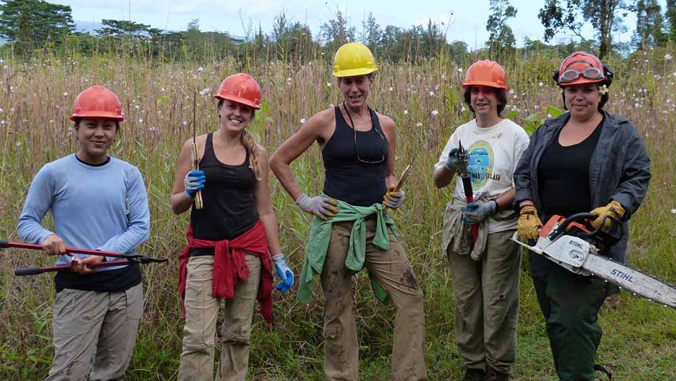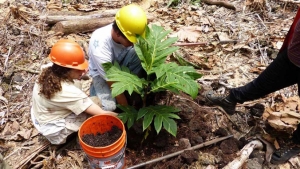
Researchers at the University of Hawaiʻi at Hilo were awarded a Bradshaw medal for their hybrid approach of incorporating non-native, non-invasive plant species into the restoration of disturbed native ecosystems.
The Bradshaw medal, named after British ecologist and restoration pioneer Tony Bradshaw, is given by the Society for Ecological Restoration. The paper, “Quandaries of a decade-long restoration experiment trying to reduce invasive species: beat them, join them, give up, or start over?” was published in the journal Restoration Ecology.
Lead author of the paper is Susan Cordell, director of the U.S. Department of Agriculture’s Institute of Pacific Islands Forestry, with co-authors Laura Warman and UH Hilo biologist Rebecca Ostertag and hydrologist Jené Michaud.

The authors argue that in some cases it is better to “give up” on the traditional goal of restoring disturbed ecosystems to their pristine native state, and instead pursue a hybrid approach that incorporates both native plant species and non-native, non-invasive plants.
“Our perspective is that in many cases we cannot keep these areas all native,” said Ostertag. “It is just not feasible or pragmatic.”
The focus of the paper is a restoration project called Liko Nā Pilina, which in Hawaiian means “growing or budding novel relationships.” The project is an ongoing effort to restore an area of Hawaiian lowland wet forest, an ecosystem found on the northeastern sides of the Hawaiian Islands that is particularly susceptible to loss of native plant species and biodiversity and domination by invasive plant species.
The team had originally written a data-rich paper focusing on weeding and invasive species reoccurrence. The original idea was not reviewing well and instead a new paper emerged.
“We decided we would morph our study into a story format and a lessons learned paper,” said Ostertag. “It took on more of a narrative structure. I think people like the paper because we explain our experience over a decade of work, and the trials and tribulations of this lowland wet forest restoration project.”
The mixing of native and non-native species may raise the eyebrows of some conservation ecologists, but Ostertag says her colleagues in Hawaiʻi have been very receptive to the hybrid approach.
To read the full story see UH Hilo Stories.
–Written by Leah Sherwood, a graduate student in the tropical conservation biology and environmental science program at UH Hilo.

